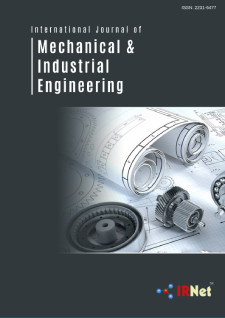International Journal of Mechanical and Industrial Engineering IJMIE
ISSN: 2231-6477

Abstracting and Indexing


IJMIE
Thermo Mechanical Analysis of Hard Faced Circular Grid Plate
Shashi Kumar
Engineering Design Division, Department of Mechanical Engineering, Anna University, Chennai
Balaguru S
Engineering Design Division, Department of Mechanical Engineering, Anna University, Chennai
Velamurali
Engineering Design Division, Department of Mechanical Engineering, Anna University, Chennai
Chellapandi P
Nuclear & Safety Engineering Group, IGCAR, Kalpakkam
Abstract
In this paper, plasma transfer arc welding of hard faced circular grid plate was studied. Hard face deposition made by Plasma Transferred Arc Welding (PTAW) on grid plate at relatively high temperature, generates residual stresses due to differential shrinkage of the molten deposit, process-induced thermal gradients and difference in coefficients of thermal expansion between the deposit and base material. However, the magnitude and distribution of the residual stresses vary depending on the preheat temperature, heat input, deposition process, and the geometry of the component. Finite element analysis of residual stress is performed with commercial FEA package ANSYS 12.0 which includes moving heat source, material deposit, temperature dependent material properties, metal plasticity and elasticity. Coupled thermo-mechanical analysis is done for welding simulation and the element birth and death technique is employed for simulation of filler metal deposition.
Recommended Citation
1] M M Mahapatra, G L Datta and B Pradhan: Three-
dimensional finite element analysis to predict the effects of
shielded metal arc welding process parameters on temperature
distributions and weldment zones in butt and one-sided fillet
welds. IMechE 2006, 837-845.
[2] Q.X.Yang, M.Yao, J.K.Park: Numerical simulations and
measurements of temperature and stress field in medium-high
carbon steel specimen after hard-face-welding. Computational
Materials Science 29 (2004) 37-42.
[3] Garg AK.: Plasma Arc Welding and Surfacing Process.
Welding Research Institute, Department of Science and
Technology, SERC School on Advances in Welding
Technology. 2002: 101 - 114.
[4] Michaleris P., DeBiccari. :Prediction of Welding Distortion.
Welding Journal, April 1997.
[5] Canas J, R Picon, F Paris, J Marin: Experimental and
numerical analysis of residual stress in welded AL-5083-O
Aluminum plates. Welding International 1994.
[6] Siva Prasad, Sankara Narayanan,.: Finite Element Analysis of
Temperature Distribution during Arc Welding using Adaptive
grid Technique. Welding Journal, April 1996.
[7] Murugan.S, Kumar.P.V, Gill.T.P.S, Raj.B, Bose. M.S.C.:
Numerical Modeling and Experimental Determination of
Temperature Distribution During Manual Metal Arc Welding.
Journal of Science and Technology of Welding and Joining,
Vol.4, No.6, March/1999, pp. 357-364.
[8] E.A.Bonifaz :Finite Element Analysis of Heat Flow in Single-
Pass Arc Welds. Welding Research Supplement, May 2000,
121-125.
[9] Peng-Hsiang Chang, Tso-Liang Teng: Numerical and
experimental investigations on the residual stresses of the butt-
welded joints, Computational Materials Science 29 (2004) 511–
522.
[10] Maeder G, Leburn JL and Sprauel JM: Present Possibilities
for the X-ray Diffraction Method of Stress Measurements.
NDT International 1981; 14 (5): 235 -248.
[11] Punitharani, K., Murugan, N., Sivagami, S.M : finite element
analysis of Residual Stresses and distortion in Hard faced
Component. Journal of scientific and Industrial research.
VOL. 69, FEB 2010 , 129-34
[12] Metals Handbook, Vol. 3, American Society for Metals, Metals
Park, OH, 1973